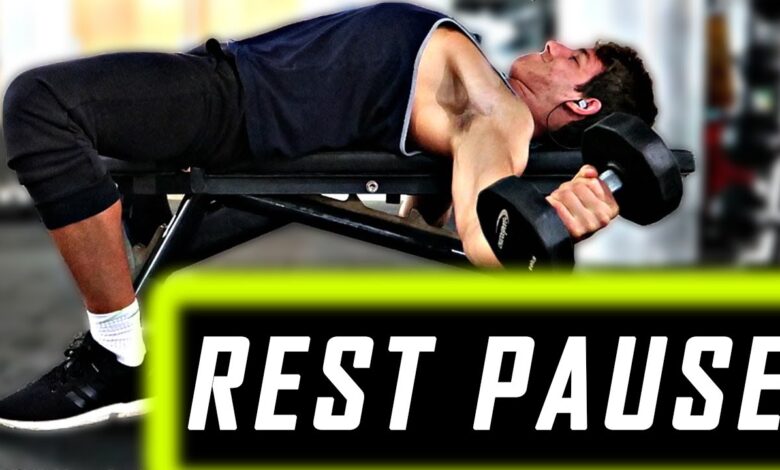
Use the Rest-Pause Method for More Gains in Less Time
Use the rest pause method for more gains in less time – Use the rest-pause method for more gains in less time – it sounds too good to be true, right? But this innovative training technique is shaking up the fitness world by maximizing your results in a shorter timeframe. By strategically combining short bursts of intense effort with brief recovery periods, you can push your muscles beyond their typical limits and unlock new levels of strength and hypertrophy.
Think of it as a supercharged version of traditional weightlifting, where you’re able to pack more work into each session without sacrificing form or risking injury. This method isn’t just about getting stronger faster, it’s also about making the most of your valuable gym time.
Whether you’re a seasoned lifter or just starting out, the rest-pause method offers a unique approach to achieving your fitness goals with efficiency and effectiveness.
Applying the Rest-Pause Method in Practice
Now that you understand the fundamentals of the rest-pause method, let’s delve into how to implement it effectively in your training routine. This section will provide a step-by-step guide, explore optimal rest durations, and offer practical workout examples for different muscle groups.
Implementing the Rest-Pause Method, Use the rest pause method for more gains in less time
The rest-pause method is straightforward to implement. Here’s a step-by-step guide:
- Choose an exercise:Select an exercise that you want to perform.
- Determine your working weight:Select a weight that allows you to perform 6-8 repetitions before reaching muscle failure.
- Perform the initial set:Complete as many repetitions as possible (AMRAP) with the chosen weight until you reach muscle failure. This is your first set.
- Rest:Immediately rest for a short period, typically 10-20 seconds.
- Perform the second set:After the rest, perform another AMRAP set with the same weight.
- Repeat steps 4 and 5:Continue with the rest-pause cycle, alternating between short rest periods and AMRAP sets, until you’ve completed the desired number of sets.
Optimal Rest Durations
The ideal rest duration between sets and reps is crucial for maximizing muscle growth and minimizing fatigue. Here are some general guidelines:
- Between sets:Aim for a rest period of 10-20 seconds. This allows for partial muscle recovery while maintaining tension and promoting metabolic stress.
- Between reps:During the rest-pause, focus on deep, controlled breathing to help with muscle recovery and oxygen replenishment.
Rest-Pause Workout Examples
Here are some practical examples of rest-pause workouts for different muscle groups:
Chest
Exercise:Barbell Bench Press Sets:3 Reps:AMRAP (6-8 reps per set) Rest:10-20 seconds between sets
Back
Exercise:Pull-ups Sets:3 Reps:AMRAP (6-8 reps per set) Rest:10-20 seconds between sets
The rest-pause method is a game-changer for those looking to maximize their gains in minimal time. It’s all about pushing your muscles to their limit, then strategically using short rest periods to recover and unleash another wave of intensity. This technique can be a powerful addition to any fitness routine, especially when combined with simple lifestyle changes.
If you’re looking for ways to boost your weight loss journey, check out this great resource: 10 Simple Changes That Lead to Weight Loss. By integrating these changes with the rest-pause method, you’ll be on your way to achieving your fitness goals in no time!
Legs
Exercise:Squats Sets:3 Reps:AMRAP (6-8 reps per set) Rest:10-20 seconds between sets
Shoulders
Exercise:Overhead Press Sets:3 Reps:AMRAP (6-8 reps per set) Rest:10-20 seconds between sets
Arms
Exercise:Barbell Curls Sets:3 Reps:AMRAP (6-8 reps per set) Rest:10-20 seconds between sets Remember:These are just examples, and you can adjust the exercises, sets, reps, and rest periods based on your individual fitness level and goals. It’s essential to listen to your body and adjust your training accordingly.
Considerations for Using the Rest-Pause Method: Use The Rest Pause Method For More Gains In Less Time

The rest-pause method, while effective for boosting muscle growth, requires careful consideration to maximize its benefits and minimize potential risks. Understanding the importance of proper form, recognizing potential limitations, and comparing it to other training techniques are crucial for making informed decisions about incorporating this method into your workout routine.
Proper Form and Technique
Maintaining proper form and technique during rest-pause training is paramount to prevent injuries and optimize muscle activation. The rest-pause method involves performing a set to near failure, resting briefly, and then repeating the process for several sets. This intense approach demands precise execution to avoid compromising form and risking injury.
- Focus on Quality Over Quantity:Prioritize perfect form over lifting heavier weights. Compromising form to push through more reps can lead to muscle imbalances and increased risk of injury.
- Control the Weight:During each repetition, maintain control over the weight throughout the entire range of motion. Avoid using momentum to lift the weight, as this can strain joints and reduce muscle activation.
- Engage the Correct Muscles:Focus on engaging the target muscle group throughout the exercise. Avoid relying on other muscle groups to assist with the movement.
- Listen to Your Body:Pay attention to any pain or discomfort during the exercise. Stop immediately if you experience any sharp pain or discomfort.
Potential Risks and Limitations
While the rest-pause method can be effective for muscle growth, it also presents certain risks and limitations that should be considered.
- Increased Risk of Injury:The intense nature of rest-pause training can increase the risk of muscle strains, tendonitis, or joint pain, especially if proper form is not maintained.
- Overtraining:Overusing the rest-pause method without adequate recovery can lead to overtraining, characterized by fatigue, decreased performance, and increased risk of injury.
- Limited Applicability:The rest-pause method may not be suitable for all exercises or individuals. It is best suited for compound exercises involving large muscle groups and may not be as effective for isolation exercises or individuals with certain medical conditions.
- Psychological Demands:Rest-pause training can be mentally demanding due to its high intensity and multiple sets to near failure.
The rest-pause method is a fantastic way to maximize your workout gains in a shorter time frame. But did you know that improving your VO2 max can also lead to bigger gains? VO2 max, or your body’s maximum oxygen uptake, is a key indicator of your aerobic fitness.
You can learn more about VO2 max and how to improve it by checking out this great article: what is vo2 max and how can you improve it. By boosting your VO2 max, you’ll increase your body’s ability to deliver oxygen to your muscles, which can help you lift heavier weights and push yourself further in your workouts, making the rest-pause method even more effective!
This can lead to fatigue, frustration, or decreased motivation.
Comparison with Other Training Techniques
The rest-pause method shares similarities with other training techniques like drop sets and supersets, but also possesses unique characteristics. Understanding these distinctions can help you choose the most appropriate technique for your goals.
The rest-pause method is a game-changer for boosting strength and building muscle, and it’s perfect for busy schedules. While you’re powering through those intense workouts, remember to fuel your body with delicious and nutritious plant-based meals! Check out these Plant-Based Holiday Recipes & for inspiration.
With the rest-pause method, you’ll be amazed at how much you can achieve in less time, and with the right plant-based fuel, you’ll be ready to conquer your next workout!
| Training Technique | Description | Pros | Cons |
|---|---|---|---|
| Rest-Pause | Perform a set to near failure, rest briefly, and repeat for several sets. | Increases muscle growth, time-efficient. | Increased risk of injury, mentally demanding, may not be suitable for all exercises. |
| Drop Sets | Perform a set to near failure, reduce the weight, and continue for several sets. | Increases muscle growth, time-efficient. | Increased risk of injury, can lead to overtraining. |
| Supersets | Perform two exercises back-to-back without rest. | Increases muscle growth, time-efficient. | May not be suitable for all exercises, can lead to fatigue. |
Real-World Examples and Testimonials
The rest-pause method has gained popularity among fitness enthusiasts and athletes due to its effectiveness in maximizing muscle growth and strength gains. Numerous individuals have shared their success stories, demonstrating the method’s practical application and benefits.
Success Stories of Individuals Using the Rest-Pause Method
The rest-pause method has been implemented by various individuals, from bodybuilders to powerlifters, to enhance their training outcomes. One notable example is that of professional powerlifter, Mark Bell, who credits the rest-pause method for helping him break numerous weightlifting records.
Bell advocates for its use in maximizing strength gains while minimizing training time. Another compelling success story comes from a fitness enthusiast named Sarah, who incorporated the rest-pause method into her routine to overcome a plateau in her weightlifting progress.
By employing this technique, she experienced a significant increase in muscle mass and strength within a short period. Sarah’s experience highlights the method’s effectiveness in breaking through plateaus and accelerating muscle growth.
Visual Examples of Rest-Pause Exercises with Detailed Descriptions
The rest-pause method can be applied to a wide range of exercises, including compound movements like squats, deadlifts, and bench presses, as well as isolation exercises like bicep curls and tricep extensions.
Example 1: Rest-Pause Barbell Bench Press
1. Warm-up Perform a few sets of light bench presses to activate the chest muscles.
2. Work Set Choose a weight that allows you to perform 6-8 repetitions with good form.
3. Rest-Pause After completing the initial 6-8 repetitions, rest for 15-20 seconds.
4. Repeat Perform another set of repetitions, aiming for 3-5 more reps.
5. Final Rest Rest for 60-90 seconds before starting the next set.
Example 2: Rest-Pause Dumbbell Bicep Curls
1. Warm-up Perform a few sets of light dumbbell curls to activate the biceps.
2. Work Set Choose a weight that allows you to perform 8-10 repetitions with good form.
3. Rest-Pause After completing the initial 8-10 repetitions, rest for 15-20 seconds.
4. Repeat Perform another set of repetitions, aiming for 3-5 more reps.
5. Final Rest Rest for 60-90 seconds before starting the next set.
Incorporating the Rest-Pause Method into Different Fitness Goals
The rest-pause method can be adapted to accommodate various fitness goals, including muscle hypertrophy, strength gains, and endurance enhancement.
Muscle Hypertrophy
To maximize muscle growth, use a weight that allows for 6-8 repetitions in the first set, followed by 3-5 repetitions in the subsequent sets. Rest for 15-20 seconds between sets.
Strength Gains
For strength gains, focus on using a heavier weight that allows for 3-5 repetitions in the first set, followed by 1-2 repetitions in the subsequent sets. Rest for 20-30 seconds between sets.
Endurance Enhancement
To improve muscular endurance, use a lighter weight that allows for 10-12 repetitions in the first set, followed by 5-7 repetitions in the subsequent sets. Rest for 10-15 seconds between sets.
Last Word
So, are you ready to experience the power of the rest-pause method? By understanding the principles, implementing the technique correctly, and optimizing your workouts, you can unlock a new level of fitness potential. This method is a game-changer for anyone seeking to build muscle, increase strength, and make the most of their training time.
Don’t just take our word for it – try it out for yourself and see the incredible results!





